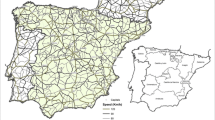Abstract
This paper describes the development of a method for strategic assessment of vulnerability in road networks. Our vulnerability analysis considers the socio-economic impacts of network degradation, on the basis of changes in the levels of accessibility provided by the degraded network. A number of standard indices of accessibility are considered, including generalised travel cost, the Hansen integral accessibility index, and the ARIA index used in Australia to assess levels of remoteness in rural areas. Simple case studies of a national strategic road network and a regional road network are used to illustrate both the general approach and specific implementations.
Similar content being viewed by others
References
Asakura Y (1999) Evaluation of network reliability using stochastic user equilibrium. J Adv Transp 33(2):147–158
Attorney-General's Department (2003, March 10) Trusted information sharing network for critical infrastructure protection. Attorney-General's Department, Canberra
Bell MGH, Cassir C (eds) (2000) Reliability of transport networks. Research Studies, Baldock, Herts
Bell MGH, Iida Y (1997) Transportation network analysis. Wiley, Chichester
Berdica K (2002) An introduction to road vulnerability: what has been done, is done and should be done. Transp Policy 9:117–127
Bonsall PW (2000) Travellers' response to uncertainty. In: Bell MGH, Cassir C (eds) Reliability of transport networks. Research Studies, Baldock, Herts, pp 1–10
BTRE (2002) Benefits of flood mitigation in Australia. Report 106. Bureau of Transport and Regional Economics, Canberra
Chen A, Yang H, Lo HK, Tang WH (1999) A capacity related reliability for transportation networks. J Adv Transp 33(2):183–200
D'Este GM, Taylor MAP (2001) Modelling network vulnerability at the level of the national strategic transport network. J East Asia Soc Transp Stud 4(2):1–14
D'Este GM, Taylor MAP (2003) Network vulnerability: an approach to reliability analysis at the level of national strategic transport networks. In: Iida Y, Bell MGH (eds) The network reliability of transport. Pergamon-Elsevier, Oxford, pp 23–44
DHAC (2001) Measuring remoteness: Accessibility/remoteness index of Australia (ARIA) (Revised edition). Occasional Paper, New Series no 14. Department of Health and Aged Cared, Canberra
DOTARS (2004) AusLink white paper. Department of Transport and Regional Services, Canberra
Evans AW (1994) Evaluating public transport and road safety measures. Accident Anal Prev 26:411–428
Gargett D., Sidebottom A (2003) Freight between Australian cities 1972 to 2001. BTRE Information Sheet 22. Bureau of Transport and Regional Economics, Canberra
Hansen WG (1959) How accessibility shapes land use. J Am Inst Plann 25:73–76
Iida Y (1999) Basic concepts and future directions of road network reliability analysis. J Adv Transp 33(2):125–134
Iida Y, Bell MGH (eds) (2003) The network reliability of transport. Pergamon-Elsevier, Oxford
Koenig JG (1980) Indicators of urban accessibility: theory and application. Transportation 9:145–172
Lam WHK (ed) (1999) Special issue on transport network reliability. J Adv Transp 33(2):121-251
Lam WHK, Xu G (2000) Calibration of traffic flow simulator for network reliability assessment. In: Bell MGH, Cassir C (eds) Reliability of transport networks. Research Studies, Baldock, Herts, pp 139–157
Lee CE (1946, May/June) New works for wartime traffic. Railway Mag 92:177–183
Morris JM, Dumble PL, Wigan MR (1979) Accessibility indicators for transport planning. Transp Res 13A:91–109
Nicholson AJ, Dalziell E (2003) Risk evaluation and management: a road network reliability study. In: Iida Y, Bell MGH (eds) The network reliability of transport. Pergamon-Elsevier, Oxford, pp 45–59
Nicholson AJ, Dante A (eds) (2004) Proceedings of the Second International Symposium on Transportation Network Reliability (INSTR04). Department of Civil Engineering, University of Canterbury, Christchurch, New Zealand
Niemeier DA (1997) Accessibility: an evaluation using consumer welfare. Transportation 24:377–396
Primerano F (2003) Towards a policy-sensitive accessibility measure. Papers of the Australasian Transport Research Forum 27, CD-ROM paper no 35
Primerano F, Taylor MAP (2005) An accessibility framework for evaluating transport policies. In: Levinson DM, Krizek KJ (eds) Access to destinations. Elsevier, Oxford, pp 325–346
Richardson AJ, Taylor MAP (1978) A study of travel time variability on commuter journeys. High Speed Ground Transp J 12(1):77–99
Sekhar SVC, Taylor MAP (2005, November 8–10) GIS approach to understanding the relationship between road network accessibility and socio-economic indicators. Proc 4th Asia-Pacific Transport and the Environment Conference, Xian, P R China
Taylor MAP (1982) Travel time variability—the case of two public modes. Transp Sci 16(2):517–521
Taylor MAP (1999) Dense network traffic models, travel time reliability and traffic management II: application to reliability. J Adv Transp 33(2):235–251
Taylor MAP (2000) Using network reliability concepts for traffic calming—permeability, approachability and tortuosity—in network design. In: Bell MGH, Cassir C (eds) Reliability of transport networks. Research Studies, Baldock, Herts, pp 217–242
Taylor MAP, D'Este GM (2004a) Critical infrastructure and transport network vulnerability: developing a method for diagnosis and assessment. Proceedings of the Second International Symposium on Transportation Network Reliability (INSTR04). Department of Civil Engineering, University of Canterbury, Christchurch, pp 96–102
Taylor MAP, D'Este GM (2004b) Safeguarding transport networks: assessment of network vulnerability and development of remedial measures. Australian Journal of Multidisciplinary Engineering, Special Edition on Engineering a Secure Australia, pp 13–22
Van Zuylen HJ (2004) The effect of irregularity of travel times on departure time choice. Proceedings of the Second International Symposium on Transportation Network Reliability (INSTR04) Department of Civil Engineering, University of Canterbury, Christchurch, pp 253–259
Yang H, Lo HK, Tang WH (2000) Travel time versus capacity reliability of a road network. In: Bell MGH, Cassir C (eds) Reliability of transport networks. Research Studies, Baldock, Herts, pp 119–138
Author information
Authors and Affiliations
Corresponding author
Rights and permissions
About this article
Cite this article
Taylor, M.A.P., Sekhar, S.V.C. & D'Este, G.M. Application of Accessibility Based Methods for Vulnerability Analysis of Strategic Road Networks. Netw Spat Econ 6, 267–291 (2006). https://doi.org/10.1007/s11067-006-9284-9
Published:
Issue Date:
DOI: https://doi.org/10.1007/s11067-006-9284-9




